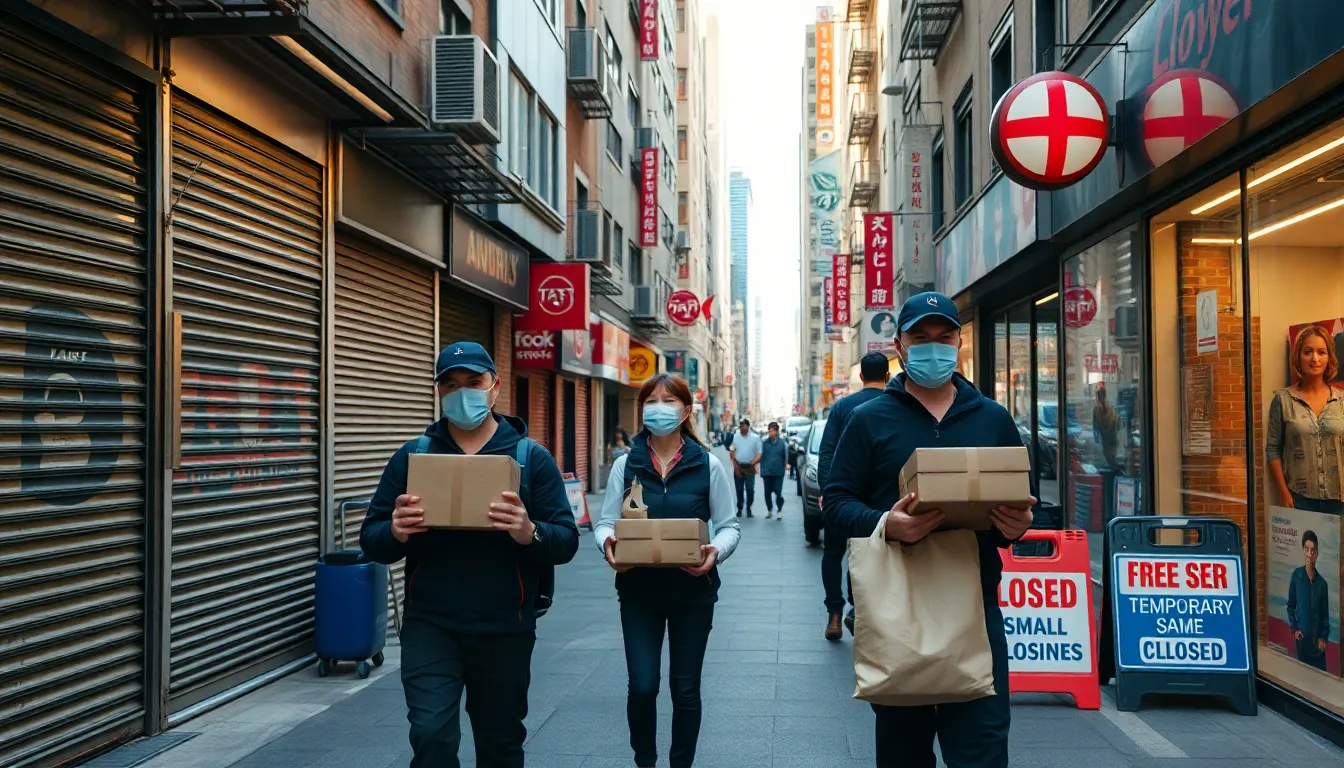Table of Contents
ToggleThe pandemic hit like a surprise plot twist in a bad movie, leaving economies reeling and businesses scrambling. From small coffee shops to multinational corporations, no one was spared from the economic rollercoaster. As they say, when life gives you lemons, you make lemonade—but this time, it felt more like trying to make a five-star cocktail with a single lemon slice and a splash of water.
In this article, we’ll dive into the wild world of pandemic economic impact. We’ll explore how job markets flipped upside down, supply chains went haywire, and consumer behavior changed faster than a cat video can go viral. Buckle up for a humorous yet insightful journey through the financial chaos that reshaped our world, because understanding these shifts might just be the key to thriving in the new normal.
Overview of Pandemic Economic Impact
The pandemic triggered significant economic challenges, affecting various sectors. Small coffee shops faced closures, while large corporations experienced declines in revenue. These disruptions resulted in job losses across industries, leading to an increased unemployment rate of 14.7% in April 2020. Businesses struggled to adapt to lockdowns and social distancing measures, creating a ripple effect throughout the economy.
Supply chains encountered severe disruptions, limiting access to products and materials. Shipping delays became common, resulting in inventory shortages. Retailers found it difficult to meet consumer demands while online demand surged. Changes in consumer behavior, such as a shift toward e-commerce, reshaped the retail landscape.
Financial markets experienced volatility as investors reacted to uncertainty. Stock prices dropped initially, but many sectors saw recovery as companies adjusted to the new normal. Government stimulus packages aimed to stabilize the economy, providing relief to small businesses and individuals. Nearly $3 trillion was allocated through various relief programs, helping to cushion the impact.
Additionally, remote work transformed the labor market. Companies embraced flexible working arrangements, altering how employees interact and collaborate. This shift may lead to long-term changes in workplace culture and productivity. Future economic forecasts suggest gradual recovery, yet the full extent of the pandemic’s impact remains to be seen.
Overall, the pandemic’s economic effects are widespread and complex, influencing employment, business operations, and consumer habits. Understanding these changes helps individuals and businesses navigate the evolving economic landscape.
Key Sectors Affected

The pandemic’s economic impact reached numerous sectors, exposing vulnerabilities and prompting significant changes.
Retail Industry
Retailers faced unprecedented challenges as stores closed and consumer habits shifted. E-commerce surged, with online sales growing by 44% in 2020. Physical stores struggled to adapt, experiencing major inventory shortfalls. Many small businesses, including local coffee shops, reported drastic revenue declines, compelling them to pivot to delivery and curbside pickups. Large retailers also grappled with supply chain disruptions, leading to empty shelves and customer dissatisfaction. Amid this turbulence, retailers that embraced digital transformation managed to survive and even thrive, illustrating the industry’s resilience.
Hospitality and Tourism
The hospitality and tourism sectors encountered severe setbacks due to travel restrictions and health concerns. Hotels saw occupancy rates plummet to historic lows, reaching just 24% in April 2020. Airlines faced massive flight cancellations, causing a loss of billions in revenue. Restaurants also struggled, with many forced to close permanently within months. Events and tourism-related businesses experienced cancellations and postponements, further compounding the losses. Despite these hardships, some establishments adapted, implementing health protocols and offering outdoor dining options, showcasing flexibility in a challenging environment.
Manufacturing and Supply Chain
Manufacturing sectors demonstrated resilience but faced unique challenges during the pandemic. Disruptions in global supply chains resulted in material shortages and delays, affecting production schedules. Factories experienced temporary shutdowns, impacting output and workforce capacity. Businesses pivoted to local suppliers to mitigate risks associated with overseas dependencies. As of mid-2021, many manufacturers began to recover, driven by increased demand, particularly in the technology and medical sectors. Innovations such as automation and digital tracking emerged, aiming to bolster supply chain efficiency and adaptability in the future.
Government Responses
Government responses to the pandemic included swift actions to mitigate economic fallout.
Fiscal Measures
Governments rolled out substantial fiscal measures to support individuals and businesses. Economic stimulus packages totaled nearly $3 trillion in the U.S., providing direct payments to citizens and funding for small businesses. Unemployment benefits extended for many, addressing skyrocketing unemployment rates. Various financial assistance programs emerged to stabilize struggling sectors, including loans and grants tailored to the hospitality and retail industries. Additionally, enhanced tax credits aimed to boost disposable income and encourage consumer spending, leading to some economic recovery signs.
Monetary Policies
Central banks implemented aggressive monetary policies to counterbalance economic strain. Interest rates were slashed to near-zero levels, encouraging borrowing and investment. Quantitative easing programs expanded, injecting liquidity into financial markets and supporting credit availability. These measures aimed to stabilize financial systems while fostering a recovery. Furthermore, emergency lending facilities targeted specific sectors and provided support, helping to cushion the effects of market disruptions. Overall, these monetary policies played a crucial role in navigating the economic landscape during uncertain times.
Long-Term Economic Changes
The pandemic has ushered in profound and lasting economic changes. The implications touch various sectors and influence future business strategies.
Remote Work Adoption
Remote work gained rapid acceptance during the pandemic, reshaping workplace dynamics. Organizations adapted to digital collaboration tools like Zoom and Slack, facilitating seamless communication. Many companies report increased productivity with flexible work arrangements. The shift encourages businesses to rethink real estate needs and reduce office space. Remote work could also lead to a more diverse workforce, as location barriers diminish. As of 2021, approximately 20% of the workforce continues to work remotely at least part-time, suggesting this trend may persist.
Changes in Consumer Behavior
Consumer behavior shifted dramatically amid the pandemic, significantly altering market trends. E-commerce growth surged by 44% in 2020, reflecting a preference for online shopping. Customers prioritize convenience and safety, prompting businesses to enhance digital offerings. Health-conscious choices emerge as a lasting focus, reshaping product development across various industries. As consumers adapt, brands that embrace sustainability and social responsibility gain favor. Surveys indicate that nearly 75% of consumers intend to maintain new buying habits post-pandemic.
The pandemic’s economic impact has reshaped industries and altered consumer behaviors in ways that will likely resonate for years. As businesses adapt to new realities many are finding innovative solutions to thrive in a digital-first world. The shift toward remote work and e-commerce is not just a temporary change but a fundamental transformation in how commerce operates.
While recovery is underway the uncertainty surrounding future economic conditions remains palpable. Understanding these shifts is crucial for individuals and organizations aiming to navigate the evolving landscape. By embracing adaptability and resilience businesses can position themselves for success in this new era.





